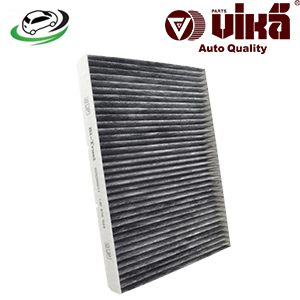-25%
Get Cabin Filter (Air-Con) AUDI A3 96-2006/TT 06-2015/TT Roadster / VW Bora 1/Bora Variant/Golf III/IV/New Beetle/Polo III/Variant 1J0819644
The cabin filter, also known as the cabin air filter, plays a crucial role in maintaining the air quality inside a vehicle. It filters out dust, pollen, pollutants, and other airborne particles before they enter the passenger compartment. Understanding its design, function, types, benefits, maintenance, and replacement is essential for ensuring a comfortable and healthy driving environment.
Design and Function
Design:
A typical cabin filter consists of several key components:
- Filter Media: The core component, often made from materials such as pleated paper, activated carbon, or HEPA (High-Efficiency Particulate Air) media. The media is designed to trap particles and contaminants from the air.
- Frame: The structural component that holds the filter media in place. It is usually made of plastic or cardboard and ensures a proper fit within the filter housing.
- Seals: Rubber or foam seals around the edges of the filter that prevent unfiltered air from bypassing the filter and ensure a snug fit within the housing.
Function:
The primary functions of the cabin filter are:
- Air Quality Improvement: Filters out dust, pollen, mold spores, and other airborne contaminants, improving the air quality inside the vehicle.
- Odor Removal: Activated carbon filters can absorb and neutralize odors from sources like exhaust fumes, pollution, and cigarette smoke.
- Protection for HVAC System: Prevents debris and contaminants from entering and potentially damaging the vehicle’s heating, ventilation, and air conditioning (HVAC) system.
Types of Cabin Filters
1. Standard Particulate Filters:
- Description: Made from pleated paper or synthetic materials that capture larger particles like dust and pollen.
- Advantages: Effective at filtering out basic contaminants, often more affordable than other types.
2. Activated Carbon Filters:
- Description: Includes a layer of activated carbon that helps to absorb and neutralize odors in addition to filtering out particles.
- Advantages: Provides enhanced air quality by removing smells and gases, such as those from exhaust fumes or smog.
3. HEPA Filters:
- Description: High-efficiency filters designed to capture very small particles, including allergens, fine dust, and microscopic pollutants.
- Advantages: Offers superior filtration compared to standard or activated carbon filters, ideal for individuals with allergies or respiratory conditions.
4. Electrostatic Filters:
- Description: Utilizes an electrostatic charge to attract and trap particles. These filters often have a longer lifespan and can be reusable.
- Advantages: Effective at capturing a wide range of particles and can be cleaned and reused in some cases.
Benefits
1. Improved Air Quality:
- Cleaner Air: Reduces the presence of airborne contaminants, leading to a healthier and more pleasant environment inside the vehicle.
- Allergen Reduction: Helps alleviate symptoms for individuals with allergies by removing pollen, mold spores, and other allergens.
2. Enhanced Comfort:
- Odor Control: Activated carbon filters help to eliminate unpleasant smells from the cabin, contributing to a more enjoyable driving experience.
- Reduced Dust: Keeps the interior cleaner by filtering out dust and other particles, reducing the need for frequent cleaning.
3. Protection for HVAC System:
- System Efficiency: Prevents debris from entering the HVAC system, which can help maintain its efficiency and extend its lifespan.
- Prevention of Damage: Reduces the risk of damage to the HVAC components caused by contaminants.
4. Improved Visibility:
- Defogging: A clean cabin filter helps the HVAC system defog the windshield more effectively, improving visibility during adverse weather conditions.
Maintenance and Troubleshooting
1. Regular Inspection:
- Check Filter Condition: Inspect the cabin filter periodically for signs of clogging, dirt buildup, or damage. Many manufacturers recommend checking the filter every 15,000 to 30,000 miles, or as specified in the vehicle’s owner’s manual.
- Monitor Airflow: Reduced airflow from the HVAC system can indicate a clogged filter, which may need immediate attention.
2. Cleaning vs. Replacement:
- Cleaning: Some electrostatic or reusable filters can be cleaned according to the manufacturer’s instructions. However, most cabin filters are designed to be replaced rather than cleaned.
- Replacement: Cabin filters should be replaced when they become clogged or damaged. Follow the vehicle manufacturer’s recommendations for replacement intervals.
3. Signs of a Faulty Filter:
- Reduced Airflow: Decreased airflow from the HVAC system can indicate that the filter is clogged and needs replacement.
- Unpleasant Odors: Persistent smells inside the vehicle may suggest that the filter is no longer effectively removing odors.
- Increased Dust: If the interior of the vehicle appears dustier than usual, it may be time to replace the cabin filter.
Replacement Procedure
1. Locate the Filter:
- Owner’s Manual: Consult the vehicle’s owner’s manual for the location of the cabin filter. It is typically located behind the glove compartment or under the dashboard.
2. Remove the Old Filter:
- Access Panel: Open the access panel or remove any components obstructing the filter’s location.
- Filter Removal: Carefully remove the old filter, noting its orientation for correct installation of the new filter.
3. Install the New Filter:
- Insert Filter: Place the new filter into the housing, ensuring it is oriented correctly and fits snugly.
- Reassemble: Reinstall any components or panels that were removed during the process.
4. Test the System:
- Check Operation: Turn on the HVAC system and ensure that the airflow is consistent and that any odors or reduced airflow issues have been resolved.
Seasonal Considerations
1. Summer:
- Air Conditioning: Ensure the cabin filter is in good condition to handle increased use of the air conditioning system.
2. Winter:
- Heater Performance: A clean filter is essential for efficient defogging and maintaining warm air circulation.
Follow us on Facebook for more parts.



